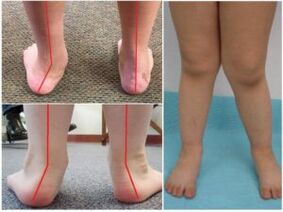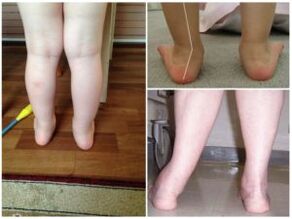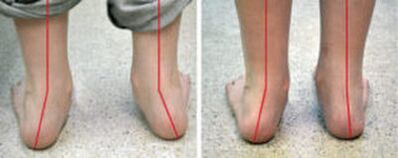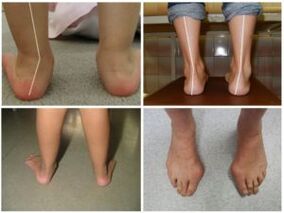Parents must pay great attention to the physical development of their kids in order to adjust the shortcomings in time.Valgus deformation of the foot in children is a frequent pathology.Although the defect is congenital or acquired, diagnosis, prevention and correction methods are similar.
What is a valgus and flat-valgus foot

The term Valgus doctors denote any curvature of joints inside from the conditional middle line (axis), in which a marked “X-shaped” deviation is noticeable.The most pronounced example of pathology is the bones on the thumbs (Hallux valgus).Valgus deformation, which is abbreviated as “valgus foot” (Sun) is the wrong setting of the foot on the horizontal support.If the one -year -old baby puts the legs together, then the back is noticeable as the inner ankle shifted closer to the opposite limb, and the heel deviated in the outside.At the same time, a flat child relies mainly on the inner (medial) part of the foot.Therefore, the plantar region, as it were, "looks" out.A variety of the disease is a flat-valgus foot (PVS).It combines flat feet with x-shaped curvature.In the baby, in addition to the formation of deformation, the set of the foot gradually flattenes.
The degree of valgus curvature
The stage of neglect of pathology is determined by the size of the angle of deviation of the heel from the median axis.
There are 4 degrees of disease:
- I - up to 15 °;
- II - 15─19 °;
- III - 20─29 °;
- IV - 30 ° or more.
1-2 stage of valgus deformation can be eliminated by conservative methods.With 3 degrees, prolonged treatment is needed.At 4 stages, a surgical correction may be required.
The causes of deformation
There are three factors, as a result of which there is a curvature of the foot: impaired intrauterine development, chronic physical overload, diseases of the musculoskeletal system.These factors weaken the ligaments, tendons, muscles, so the foot is not fixed by them in a normal anatomical position.
The reasons for the acquired valgus, flat-valgus foot (code M21.0 in ICD-10):
- Premature setting on the legs, when the joints of the baby are not yet ready for such loads;
- “Wrong” shoes (narrow block with a thin high heel, without supinators).
- muscle hypotension, congenital myodistrophy;
- large weight, obesity;
- rickets;
- neuromuscular diseases (polio, children's cerebral paralysis, polyneuropathy of various etiologies);
- congenital dislocation of the thigh and dysplasia of the hip joints;
- trauma to the foot or lower leg;
- Long -term immobilization of the leg with gypsum, tutor or pillow of Freik.
The congenital origin of the valgus and flat-valgus defect of the structure of the foot (Q66.6 code in the ICD-10) may be due to injury in the abdomen transferred by a pregnant woman, or a genetic disease.Such curvature can be seen immediately after birth, sometimes it manifests itself before the baby begins to walk.
How to determine the deformation of the stop

A change in the configuration of the lower limb is set along the axis of the leg.This is the name of the conventional line, drawn visually from the center of the hip joint through the knee, ankle to the middle of the calcaneus.The norm implies the passage of the axis through the center of joints that should not be shifted from it to the right or left.
Characteristic features
In newborn babies, with the innate nature of Valgus, it is found immediately or in the first months of life.Most often, signs of a valgus defect in children appear after a year and a half.The presence of the ailment can be suspected by the behavior and gait of the baby.Most often, the following general symptoms of pathology are found:
- increased flexibility of small joint joints;
- decrease in the height of the set of the sole;
- the displacement of the center of gravity (when trying to walk, the child relies only on the medial side of the foot, its outer edge can slightly rise);
- uncertain, shuffling gait;
- Fast physical fatigue, the need for rest, to give the baby to relax;
- regular complaints about pain in the legs, unwillingness to walk;
- light swelling and redness of the skin in the foot and ankle;
- Uneven wear of shoes, more expressed from the inner edge of the sole.
Methodology for identifying deformation
Defect diagnostics methods include an examination with an orthopedic of the baby’s foot, followed by direction of the baby for instrumental examination.He is made an X -ray of the feet in three projections to find out the degree of bone displacement.They also carry out a planetography to determine the height of the ardor and the degree of severity of flat feet.Using the post -meter, the center of pressure on the sole is calculated.This is an effective diagnostic method, since it allows you to identify valgus deformations in the early stages.Sometimes, to clarify the results of the examination, an ultrasound of the foot is made.The visual signs of pathology are the sole, slightly turned and raised in the lateral direction, the displacement of the heel, outward from the middle line.With flat-valgus deformation, the disappearance of the vault, flattening of the foot is noted.To exclude the neurological causes of the defect, the orthopedist directs the child to a narrow specialist.
Methods of correction
To eliminate Valgus, the main tasks are to give the foot of the correct position and the subsequent strengthening of the ligaments attached to the heel and muscle tendons.
Fixation of the joint in a conservative way
With an innate defect, gypsum dressings or tutors are used.The purpose of the rigid fixation of the foot at the right angle is to eliminate curvature by immobilization.While the ossification is not completed, the fabrics are elastic, so they are easily amenable to such correction.With the acquired valgus defect, to return the correct setting of the foot, orthopedic shoes are made to the child.It should not cause discomfort when used.A special shoe insole has lateral stiff supercinators, a soft pillow (pelot) under the vault of the foot.Such shoes are also recommended to be worn during rehabilitation after surgery and in order to consolidate the results of treatment.
A variety of insoles with a valgus foot
Experts recommend ordering orthoses, shoes or insoles for children in orthopedic salons according to individual sizes and casts of the foot.The price of the product will be slightly higher, but the use will give a more noticeable result.
Strengthening small joints

For general hardening and tonic muscles of the lower extremities, it is recommended to use contrasting foot baths.For this, the feet are dipped alternately in a container with cold and hot water.They start with a temperature of 36 ° C with a liquid, then this value is changed every week by 1 ° C. Gradually bringing to a range from 14 to 40 ° C.
It is useful to do the following exercises:
- alternate walking on socks, heels, inner, outer edges of the sole;
- collecting small objects, clutching fabric or paper, drawing with the fingers of the feet;
- Sking the ball sole on the floor;
- a set of exercises for the fingers (bending-extinguishing, breeding and closing);
- Walking on pebbles and an uneven surface.
The orthopedist can prescribe a massage course of the lumbar spine, affected by the lower limb or both legs.It is optimal to carry it out after heating with paraffin or ozokeritic application.The muscles of the inner surface of the legs are acted by tonic massage movements (patting, kneading).The outer surface of the legs should be massaged with relaxing techniques - stroking, rubbing.
Physiotherapeutic procedures
If the deformation of the foot provoked inflammation of the articular structures, tendons of muscles, the child is prescribed electrophoresis with painkillers and anti -inflammatory drugs, magnetotherapy, black wax application, paraffin, and therapeutic mud.For selective muscle stimulation, diadynamic currents are used.
Surgical treatment
In early childhood, radical methods of therapy are not used.But if the defect interferes with normal walking, the operation is done to young children.During surgical intervention, doctors using metal elements (titanium wire, screws, plates) fix deformed joint in a normal position.Surgeons can also strengthen the joint by moving the tendon of the fibula or lengthening the Achilles tendon.After these operations, rehabilitation includes the use of orthopedic products, massage, physiotherapy, and physiotherapy exercises.
Preventive measures
To prevent the valgus deformation of the foot, you need to buy a child comfortable shoes corresponding to the size of the leg, the anatomical structure of the foot.How to choose - watch the recommendations of E.O. Komarovsky at the video.The doctor says about the disease that this is a frequent violation in children and help to correctly form the foot to be formed until the age of 12.The teenager most likely needs an operation to correct the pronounced defect of the foot.The child should walk barefoot on sand, grass, walk a lot, eat fully.Dosed sunbathing prevents rickets in children, which is one of the causes of the disease.Physical education, hardening of the body, regular courses of general strengthening massage.Gymnastics for the muscles of the foot is also important, including the creation of a pattern of a leg in the sand.Active outdoor games, swimming also contribute to strengthening the muscles and ligaments of the lower extremities.All these measures prevent the development of foot defects.It is forbidden to put on the legs of the child up to 7.5 gra p .8 months, when the joints and bones of the lower extremities have not yet been strengthened.It is unacceptable to miss the planned examinations of the pediatrician and narrow specialists, which allow you to identify pathology at an early stage.
Doctors 'answers to parents' questions
How to warn the congenital valgus deformation?Unfortunately, the vice of the development of the musculoskeletal system cannot be prevented.Even if they did not find any deviations in the hospital, the baby should regularly be inspected by a pediatrician, receive massage, walk barefoot on an uneven, but safe surface for legs.At home, it is recommended to use a massage rug.The acquisition of high -quality shoes also helps to put the foot in the correct position, to form a set of physiological heights.Such prevention will stop the progression of even congenital valgus foot.
Which doctor treats pathology?
If necessary, the pediatrician directs the baby to the children's orthopedist, traumatologist, surgeon.
What is a varior foot?
Varus deviations are the displacement of the heel bone inside from the midline.In this case, the set of the foot is made very high, and the center of pressure is shifted to the outer edge of the sole.A defect is treated with the same methods as valgus deformation, only the deviation angle is adjusted from the opposite side of the foot.
Valgus deformation of the foot in children: consequences and correction
The valgus deformation of the foot is a pathological change in the musculoskeletal system, in which the height of the set of the foot decreases, and the axis of the lower extremities shifts.
The defect may be congenital or develop in childhood, leading to flat feet, violation of posture and other health problems.As a rule, it is adjusted conservatively, in the course of long therapy with charging, massages, physiotherapy.With regular work on deformation, you can achieve proper setting of the leg and confident gait.
Flat-valgus deformation of the feet in children-symptoms
This leg defect can be recognized by the following external signs:
- The foot is littered with the inner rib, the child rests on the inner part of the foot;
- The heel and fingers are deployed outward;
- The middle part of the foot is flat or noticeably lowered;
- When the knees are reduced, the legs acquire an ix-brow shape, the legs do not converge together, between them the distance of about 4-5 cm remains;
- uncertain, clumsy gait, the child often stuck, shuffles;
- The kid quickly gets tired on a walk.

When can a defect manifest?
The arch of the foot begins to form from the moment when the baby tries to take the first steps.For infants, a flat foot is considered the norm.When taking on an vertical position independently, children develop a musculoskeletal system, “accustom” it to new functions.Bones and ligaments begin to experience loads, the foot is strengthened and takes the correct anatomical shape.This usually happens up to 1.5 years.If by this age the vaults remain flat, there is no formed bend, doctors define this as valgus deformation of the foot.As a rule, violations are detected on medical examinations, but if the parents independently noticed the above signs, you need to immediately contact an orthopedic.If you start adjustment as early as possible, restoration is faster and without serious consequences.
Conclusion
Parents need to devote the maximum time to the prevention of defects in the physical development of the baby, including gymnastics, massage courses and other recreational activities.If the valgus deformation of the foot in children is not eliminated by conservative treatment, then you need to agree to surgical intervention to correct the shape of the foot.After all, the advanced pathology is fraught with the development of arthrosis, diseases of the spine, and shortening of the limb.























